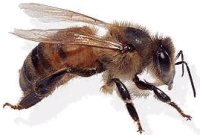GETTING STARTED
Where to find out information.
A visit to a local or national honey show organised by a local association will provide the opportunity to talk to experienced beekeepers about their craft and to view the displays of beekeeping equipment and products.
Newcomers are always made welcome at meetings of the local beekeepers’ association and will be given the opportunity to observe the beekeepers as they work with their hives. Members receive monthly newsletters and regular lectures on topics related to the craft. The local library or the British Beekeepers’ Association will supply details of your nearest branch. In America contact Beesource.com.
Some local authorities and agricultural colleges run evening classes in beekeeping. The best time to start is in the late Winter with an introduction to the basic theory of beekeeping, followed by practical lessons running concurrently with your own beekeeping activities during Spring and early Summer. The final lessons during the Autumn should provide instruction on how to prepare the bees for Winter and the following season.
Getting started
If you are starting beekeeping from scratch you will need to buy a nucleus of bees. A nucleus is a young colony of bees covering just a few frames inside the hive
Before taking delivery of the bees you must take the following steps:
- Choose a good site for the hive
- Order the hive well in advance as there may be a waiting list at the start of the new season
- Plan your first year of beekeeping carefully and remember that it is a long-term and time-consuming commitment.
What you need before you start
- A clean hive stocked with new frames and wax foundation.
- Full protective clothing.
- A smoker, fuel and a lighter.
- A hive tool to prise apart the frames of the nucleus.
- A white sheet to place in front of the hive as you transfer bees from their travelling box. If you drop the queen or any other bees you will see them and hopefully not trample on them.
The nucleus of bees should be ordered from the supplier in the late Winter for delivery in the Spring, their arrival depends on the weather.
A nucleus consisting of around five frames housing approximately 10,000 bees can be dispatched to you in a travelling box. The bees can travel quite safely by train in the box and can be left unattended for a few days. They should be transferred from the box to the hive as soon as possible however because the queen will be laying eggs rapidly and the bees quickly become overcrowded.
